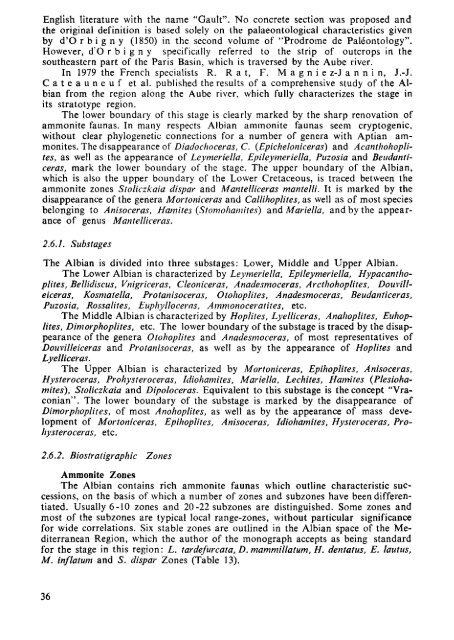THE MEDITERRANEAN LOWER CRETACEOUS
THE MEDITERRANEAN LOWER CRETACEOUS
THE MEDITERRANEAN LOWER CRETACEOUS
You also want an ePaper? Increase the reach of your titles
YUMPU automatically turns print PDFs into web optimized ePapers that Google loves.
English literature with the name "Gault". No concrete section was proposed and<br />
the original definition is based solely on the palaeontological characteristics given<br />
by d'O г b i g n у (1850) in the second volume of "Prodrome de Paleontology".<br />
However, d'O г b i g n y specifically referred to the strip of outcrops in the<br />
southeastern part of the Paris Basin, which is traversed by the Aube river.<br />
In 1979 the French specialists R. Rat, F. M a g n i e z-J a n n i n, J.-J.<br />
Cateauneuf etal. published the results of a comprehensive study of the Albian<br />
from the region along the Aube river, which fully characterizes the stage in<br />
its stratotype region.<br />
The lower boundary of this stage is clearly marked by the sharp renovation of<br />
ammonite faunas. In many respects Albian ammonite faunas seem cryptogenic,<br />
without clear phylogenetic connections for a number of genera with Aptian ammonites.<br />
The disappearance of Diadochoceras, C. (Epicheloniceras) and Acanthohoplites,<br />
as well as the appearance of Leymeriella, Epileymeriella, Puzosia and Beudanticeras,<br />
mark the lower boundary of the stage. The upper boundary of the Albian,<br />
which is also the upper boundary of the Lower Cretaceous, is traced between the<br />
ammonite zones Stoliczkaia dispar and Mantelliceras mantelli. It is marked by the<br />
disappearance of the genera Mortoniceras and Callihoplites, as well as of most species<br />
belonging to Anisoceras, Hamites (Stomohamites) and Mariella, and by the appearance<br />
of genus Mantelliceras.<br />
2.6.1. Substages<br />
The Albian is divided into three substages: Lower, Middle and Upper Albian.<br />
The Lower Albian is characterized by Leymeriella, Epileymeriella, Hypacanthoplites,<br />
Bellidiscus, Vnigriceras, Cleoniceras, Anadesmoceras, Arcthohoplites, Douvilleieeras,<br />
Kosmatella, Protanisoceras, Otohoplites, Anadesmoceras, Beudanticeras,<br />
Puzosia, Rossalites, Euphylloceras, Ammonoceratites, etc.<br />
The Middle Albian is characterized by Hoplites, Lyelliceras, Anahoplites, Euhoplites,<br />
Dimorphoplites, etc. The lower boundary of the substage is traced by the disappearance<br />
of the genera Otohoplites and Anadesmoceras, of most representatives of<br />
Douvilleieeras and Protanisoceras, as well as by the appearance of Hoplites and<br />
Lyelliceras.<br />
The Upper Albian is characterized by Mortoniceras, Epihoplites, Anisoceras,<br />
Hysteroceras, Prohysteroceras, Idiohamites, Mariella, Lechites, Hamites (Plesiohamites),<br />
Stoliczkaia and Dipoloceras. Equivalent to this substage is the concept "Vraconian".<br />
The lower boundary of the substage is marked by the disappearance of<br />
Dimorphoplites, of most Anohoplites, as well as by the appearance of mass development<br />
of Mortoniceras, Epihoplites, Anisoceras, Idiohamites, Hysteroceras, Prohysteroceras,<br />
etc.<br />
2.6.2. Biostratigraphic Zones<br />
Ammonite Zones<br />
The Albian contains rich ammonite faunas which outline characteristic successions,<br />
on the basis of which a number of zones and subzones have been differentiated.<br />
Usually 6-10 zones and 20-22 subzones are distinguished. Some zones and<br />
most of the subzones are typical local range-zones, without particular significance<br />
for wide correlations. Six stable zones are outlined in the Albian space of the Mediterranean<br />
Region, which the author of the monograph accepts as being standard<br />
for the stage in this region: L. tardefurcata, D. mammillatum, H. dentatus, E. lautus,<br />
M. inflatum and S. dispar Zones (Table 13).<br />
36

















